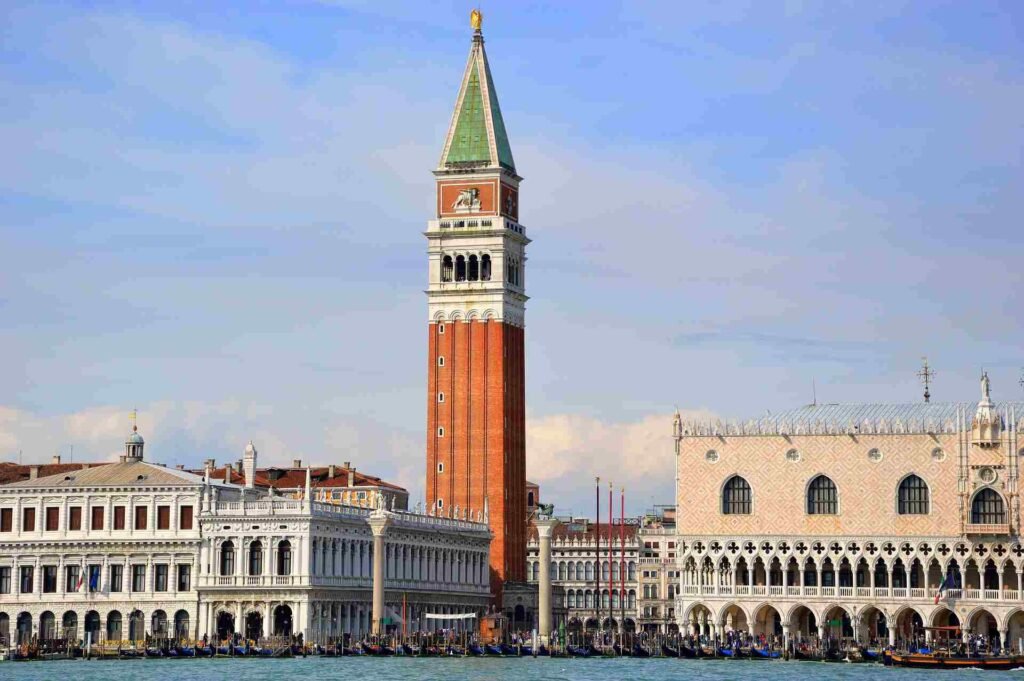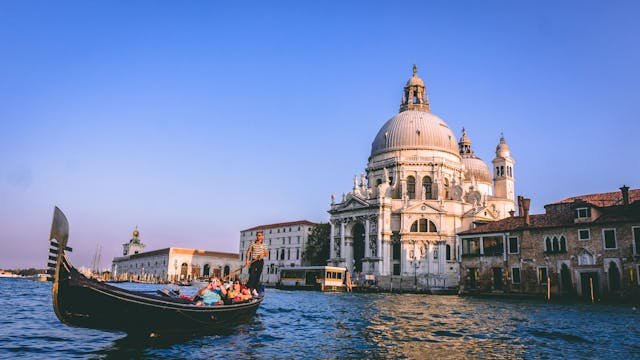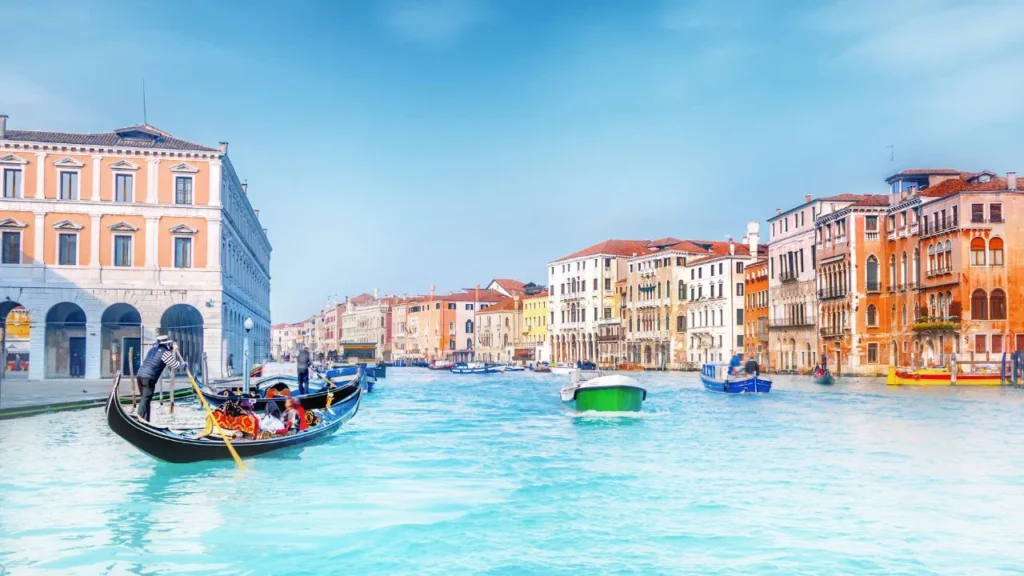St. Mark’s Basilica: Venice’s Stunning Church

St. Mark’s Basilica, or Basilica di San Marco, is one of Venice’s most iconic landmarks. Located in the heart of Piazza San Marco, this majestic church has been captivating visitors for centuries with its breathtaking beauty and rich history.
The basilica was originally built in the 9th century to house the relics of St. Mark the Evangelist, which were smuggled from Alexandria by Venetian merchants. Over the years, it was rebuilt and expanded, becoming the grand structure we see today. Its architecture is a blend of Byzantine, Gothic, and Renaissance styles, making it a masterpiece of Venetian creativity.
What immediately catches your eye is the stunning facade, adorned with intricate mosaics, statues, and arches. The gilded domes gleam in the sunlight, symbolizing Venice’s former wealth and power. Inside, the opulence continues with over 8,000 square meters of shimmering mosaics that tell biblical stories. The golden Pala d’Oro, a jewel-encrusted altarpiece, is another highlight that leaves visitors in awe.
St. Mark’s Basilica is more than a church; it’s a symbol of Venice’s heritage. Entrance to the basilica is free, but some areas, like the museum and the Pala d’Oro, require a small fee. For the best experience, visit early in the morning or late afternoon to avoid crowds.
Whether you’re drawn by its history, art, or spirituality, St. Mark’s Basilica is a must-see that embodies the beauty and grandeur of Venice.
- Travel Tip: Arrive early in the morning to avoid long lines and the midday crowds. Early access will also give you a peaceful, more intimate experience.
The Grand Canal: Venice’s Main Waterway
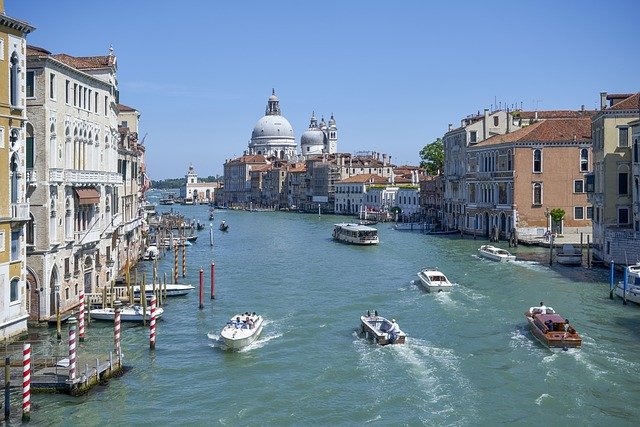
The Grand Canal, or “Canal Grande,” is the beating heart of Venice. This iconic waterway snakes through the city in a grand S-shape, stretching about 3.8 kilometers and dividing Venice into two sides. It’s more than just a canal—it’s a journey through the city’s rich history, stunning architecture, and vibrant life.
Lined with over 170 historic buildings, many dating back to the 13th to 18th centuries, the Grand Canal is a showcase of Venice’s architectural splendor. Palazzos like Ca’ d’Oro and Ca’ Rezzonico flaunt intricate facades, reflecting the grandeur of Venetian aristocracy. The Rialto Bridge, the oldest and most famous bridge crossing the canal, is a breathtaking sight and a hub of activity.
The best way to experience the Grand Canal is from the water. Hop on a vaporetto (water bus) for an affordable and scenic ride or, for a touch of romance, take a gondola and glide through the water as the city reveals itself around every bend.
Evenings on the Grand Canal are particularly magical, with the city’s lights shimmering on the water’s surface. It’s a time when the canal feels alive, echoing the hum of boats and the whispers of history.
Whether you’re admiring the views, exploring its many attractions, or simply soaking in the atmosphere, the Grand Canal isn’t just a waterway—it’s the soul of Venice and a sight you’ll never forget.
- Travel Tip: For an unforgettable view, take a Vaporetto ride at sunset when the fading light reflects beautifully off the water and buildings.
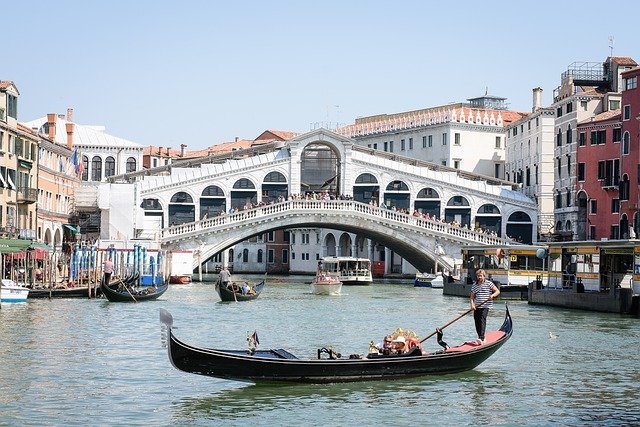
The Rialto Bridge, or “Ponte di Rialto,” is one of Venice’s most famous landmarks and a true symbol of the city. Spanning the Grand Canal, this historic bridge has connected the bustling districts of San Marco and San Polo for over 400 years.
Built in 1591, the Rialto Bridge was an engineering marvel of its time. Designed by Antonio da Ponte, it replaced earlier wooden bridges that had collapsed or burned down. Its stone structure and elegant arch have stood the test of time, making it a favorite spot for both locals and tourists.
The bridge is not only functional but also beautiful. Its wide walkway is lined with small shops selling jewelry, souvenirs, and Venetian glass. From the top, you can enjoy stunning views of the Grand Canal, with its busy boats and historic palazzos. It’s a perfect spot to take photos and feel the lively spirit of Venice.
The Rialto area around the bridge is full of life, with markets selling fresh seafood, fruits, and vegetables. This has been a trading hub for centuries, and the energy is still vibrant today.
Whether you’re shopping, sightseeing, or simply crossing it, the Rialto Bridge is a place where history and charm come together. It’s not just a bridge—it’s a piece of Venice’s story that you won’t want to miss.
- Travel Tip: Visit early in the morning to enjoy the bridge before it gets crowded, and capture stunning photos in the soft morning light.
Doge’s Palace: A Palace Full of History
The Doge’s Palace, or Palazzo Ducale, is one of Venice’s most impressive landmarks. Located in St. Mark’s Square, this stunning building was once the residence of the Doge, the leader of Venice, and the center of Venetian government for centuries.
Built in the Venetian Gothic style, the palace is both elegant and grand. Its pink-and-white marble facade is adorned with delicate arches and carved details that catch your eye immediately. Inside, the splendor continues with vast halls, grand staircases, and rooms filled with magnificent frescoes and golden decorations.
One of the highlights is the Sala del Maggior Consiglio (Hall of the Great Council), where Venice’s rulers made important decisions. The ceiling and walls are covered with art by Venetian masters, including Tintoretto and Veronese. The Bridge of Sighs is another must-see. This enclosed bridge connects the palace to the prisons, and it’s said that prisoners sighed as they saw their last view of Venice through its small windows.
A visit to the Doge’s Palace is like stepping back in time. You can explore the Doge’s private apartments, the courtrooms, and even the dark prison cells. Tickets are required, but the experience is worth every moment.
Whether you’re a history lover or an art enthusiast, the Doge’s Palace offers a glimpse into Venice’s powerful past and the beauty that has endured through the ages.
- Travel Tip: Visit Doge’s Palace in the late afternoon to avoid the larger midday crowds, and stay for the beautiful sunset views over the lagoon from the nearby waterfront.
St. Mark’s Campanile: A Tower with a View

St. Mark’s Campanile, or Campanile di San Marco, is one of Venice’s most iconic landmarks and the tallest building in the city. Standing 98.6 meters high, this majestic bell tower offers breathtaking views of Venice, its lagoon, and even the distant Dolomite Mountains on clear days.
The tower’s history dates back to the 9th century, but the structure you see today was rebuilt in 1912 after the original collapsed in 1902. Its simple brick design contrasts beautifully with the ornate architecture of St. Mark’s Basilica nearby. At the top, a golden weathervane of the Archangel Gabriel glimmers in the sunlight.
Visitors can take an elevator to the top, making it an easy and accessible way to enjoy panoramic views of Venice. From there, you’ll see the winding canals, historic rooftops, and the shimmering waters of the lagoon stretching into the horizon. It’s the perfect spot for photography or simply soaking in the beauty of the city.
The campanile also houses five bells, each with a unique purpose during Venice’s history, from signaling council meetings to announcing executions. Today, they add to the charm of this iconic tower.
A visit to St. Mark’s Campanile is an unforgettable experience. Whether you’re marveling at the view or imagining the history it has witnessed, this tower truly lets you see Venice from a new perspective.
- Travel Tip: Consider visiting the Campanile on a clear day for the best visibility, and take advantage of the fantastic photo opportunities.

